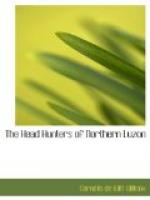The Mountain Province itself is the outcome of the difficulties encountered in governing the wild tribes so long as these were left in provinces where either their interests were not paramount, or else the difficulties of administration were unduly costly or difficult. Established in 1908, it has a Governor, and each of its seven sub-provinces a Lieutenant-Governor, the sub-province as far as possible including people of one and of only one tribe. The creation of this province was a great step forward in promoting the welfare of the highlanders.
A word must be said here in explanation of the nomenclature of the mountain tribes. Generically, having in mind the meaning of the word, they are all Igorots. But it is the practice to distinguish the various elements of this great family by different names, restricting the term “Igorot” to special branches, as Benguet Igorot, Bontok Igorot, meaning those who live in Benguet or Bontok. The other members are known as Ifugao, Ilongot, Kalinga, and so on. [5] Lastly, the following extract from the “Census of the Philippine Islands” [6] gives some idea of the mountain system in which dwell the people whom we are about to visit.
“West of this Valley [the Cagayan] and separating it from the China Sea, stands a broad and complex system of mountains, known as the Caraballos Occidentales. Its length is nearly 200 miles, and its breadth, including the great spurs and subordinate ranges and ridges on either side, is fully one-third its length. The central range of the system forms the divide between the waters flowing to Cagayan River on the east and those flowing to the China Sea on the west. Its northern part bears the name Cordillera Norte. Farther south it is called Cordillera Central, while the southern portion is called Cordillera Sur.” “At its south end the Cordillera Sur swings to the east, and, under the name of Caraballos Sur, joins the Sierra Madre, or East Coast Range.”
This description, it must be understood, gives no adequate idea of the local intricacy of the system, while at the same time it is precisely this intricacy, both vertical and horizontal, that increases the cost and difficulty of making roads, and that has served in the past to keep the inhabitants of these regions apart.
CHAPTER II
Annual inspection of the mountain tribes.—We set out from Baguio.—Pangasinan Province.—Agno River.—Reception by the people.
Every year Mr. Worcester makes a formal tour of inspection through the Mountain Province to note the progress of the trails and roads, to listen to complaints, to hear reports, devise ways and means of betterment and in general to see how the hillmen are getting on. This tour is a very great affair to the highlanders, who are assembled in as great numbers as possible at the various points where stops are made; during the stay of the “Commission” (as Mr. Worcester is universally called by the highlanders) at the points of assemblage, the wild people are subsisted by the Government.




